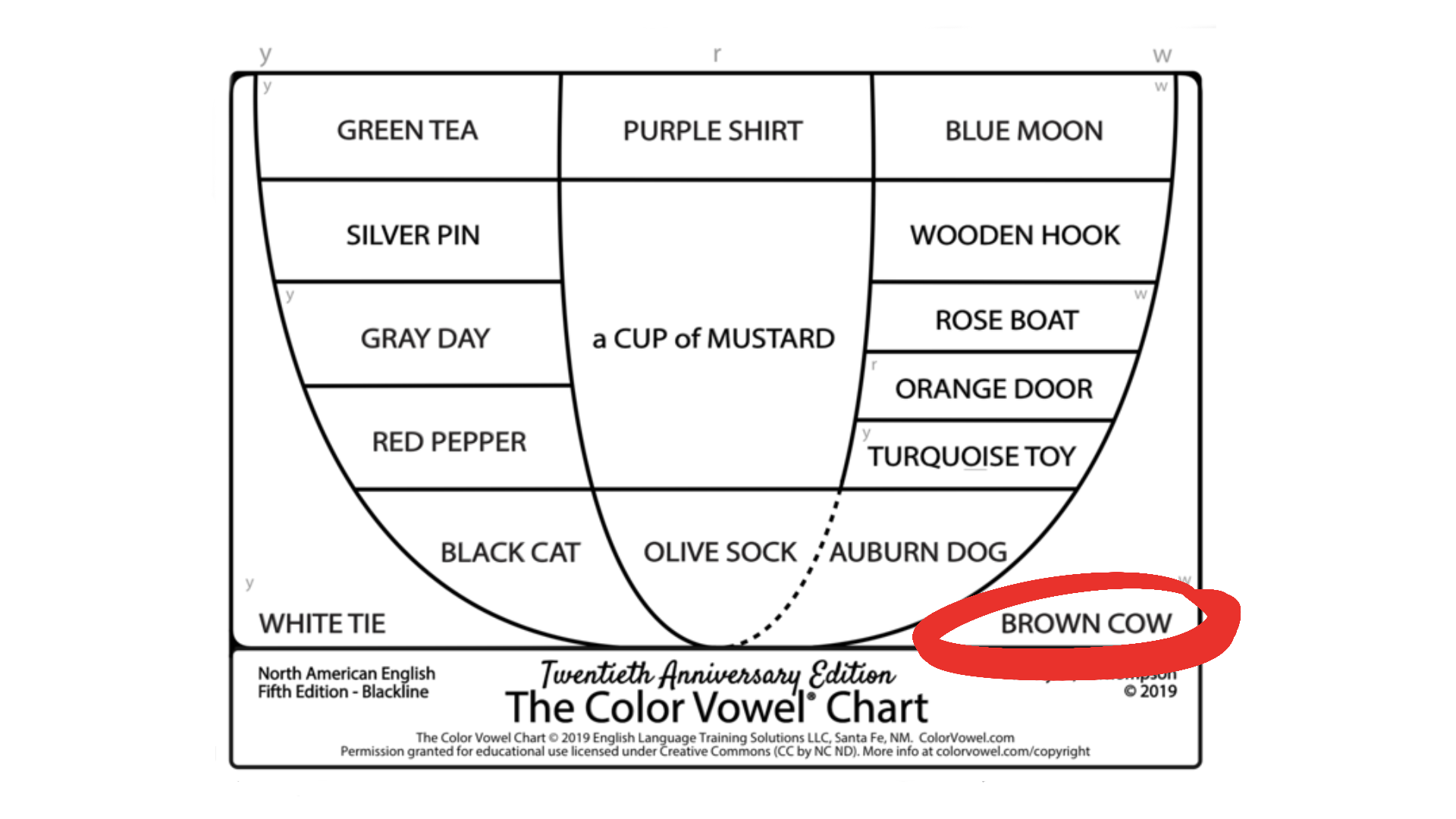The OW-Sound
This sound is another diphthong, one of those combo vowel sounds that start as one vowel sound and transition to the next.
The International Phonetic Alphabet (IPA) symbol for this sound is /aʊ/. So it’s a combination of [a] and [ʊ].
In General American English and Canadian English, the [aʊ] sound is the sound in the word ‘NOW’.
SYMBOL
On the IPA vowel chart, the first part of the diphthong pair starts in the bottom left and transitions to the top right for the second part of the sound.
The Color Vowel® Chart, created by Karen Taylor and Shirley Thompson in 1999, is another visual organizer for spoken English and represents how to learn and think about vowels. It refers to this sound as the ‘BROWN COW’ sound or the BROWN vowel. Notice the consistent placement on the mid-right corner of each respective chart.
The Color Vowel® Chart, 5th Edition © 2019. ColorVowel.com. Used with Creative Commons licensing (CC BY-NC-ND).
SOUND
So, the OW-sound in NOW is a diphthong. Your mouth will change position and shape as youu say the sound because it combines 2 vowel sounds.
The beginning position of this diphthong, [a], is not a vowel in the General Canadian English or General American English accent. So instead, a good starting point is the AA-sound in BAT [æ].
Your mouth will start on the position of the /æ/ sound and then allow your mouth and lips to close as you finish on the position of the /ʊ/-sound.
In the beginning, the lips should not round at all. Eventually they do for the 2nd vowel shape but for the first, absolutely not.
The jaw should be dropped and the tongue flat in the mouth. Then, you start rounding the lips, closing the jaw and lifting the back of the tongue.
FEATURES
The [a] sound features are as follows.
Its vowel height is open, also known as low, which means the tongue is positioned far from the roof of the mouth – that is, low in the mouth.
Its vowel backness is front, which means the tongue is positioned forward in the mouth without creating a constriction that would be classified as a consonant.
It is unrounded, which means that the lips are not rounded.
The [ʊ] sound features are as follows.
Its vowel height is near-close, also known as near-high, which means the tongue is not quite so constricted as a close vowel (high vowel).
Its vowel backness is back, which means the tongue is positioned back in the mouth without creating a constriction that would be classified as a consonant.
Its roundedness is protruded, which means that the corners of the lips are drawn together, and the inner surfaces are exposed.
So, comparing the individual vowel sounds, the biggest aspects of change are from open vowel to near-close, frontness to blackness and unrounded to rounded. That is what makes the diphthong special because this transition in all aspects of the vowel is the distinction of the diphthong.
VISUAL REPRESENTATION
In English, the [aʊ] sound is reflected in spelling in many different ways. Depending on the specific English dialect, it may be written using any of the following letters:
OW - down, frowned, town, power, allow, how, rowdy,
OU - pound, mouse, spout, round, our, without
OUGH - bough, plough
The /aʊ/-sound can appear in all positions of a word (beginning, middle, end) but typically is in the middle or end.
The reason why I’m especially showing you the different spelling combinations that can create this sound is that there will ALWAYS be exceptions, weird spellings, or other things that impact how reliable the written representation will be. For example, FRAU, CIAO, and TAO all have the OW-sound without the typical -OW- or -OU- spelling.
LISTENING
You need to be able to identify the sound; rhyming is an excellent way to match it properly. So, if you are not good already, start practicing rhyming and hearing the sound.
| OW | AW |
|---|---|
| crowd | crawled |
| Paolo | Paul Oh |
| mouth | moth |
I’m breaking down every single sound down for you so that you can learn how to produce each sound in English accurately. Sometimes, we’ll have easier sounds and sometimes we’ll have harder sounds.
If you’ve grasped this sound, then great! But if you’ve got a tip that might work for others, or you took a while to produce this sound correct but something clicked for you, let me know down below in the comments. My goal is to have a community know what to do when they’re stuck!



